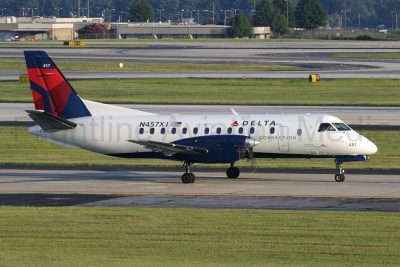2 Propeller Engines
Aircraft with two prop-driven engines on the wings are commonly known as commuter planes or turboprops. There are many of them in private aviation, but in commercial airline service the most common ones are the Dash-8, ATR-72, Embraer Brasilia, and the Saab 340. Place your mouse over the red links below to see the illustrations highlighted with the differences.
Background
What to Look For
Both the Dash-8 (top right) and ATR (bottom right) have their wings on the top of the fuselage. The major difference is that on the Dash-8, the landing gear retract up into a space under the engine housing. The ATR’s landing gear retracts up into the bottom of the fuselage.
There have been 4 different versions of the Dash-8 built since its introduction and all differ in length, passenger capacity, and engines. The latest version shown here, in production since 2000, is the longest and nearly 20 feet longer than an ATR.
Besides the landing gear, an ATR can be distinguished from a Dash-8 by its tailcone, which is longer and pointed. The ATR comes in two versions with several sub-types each: the ATR-42 and ATR-72, which is 14 feet longer. The ATR-72 can carry up to 78 passengers 825 nautical miles while a Dash-8 can carry up to 90 passengers 1,100 nautical miles.
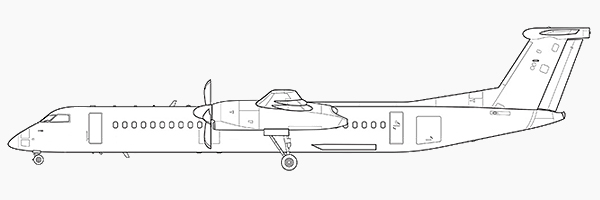
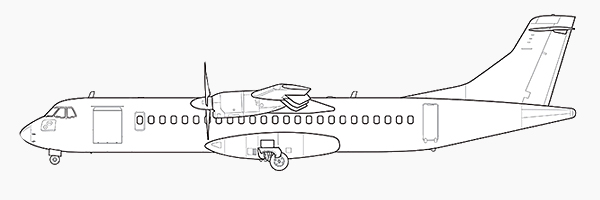
Both the Dash-8 (top) and ATR (bottom) have their wings on the top of the fuselage. The major difference is that on the Dash-8, the landing gear retract up into a space under the engine housing. The ATR’s landing gear retracts up into the bottom of the fuselage.
There have been 4 different versions of the Dash-8 built since its introduction and all differ in length, passenger capacity, and engines. The latest version shown here, in production since 2000, is the longest and nearly 20 feet longer than an ATR.
Besides the landing gear, an ATR can be distinguished from a Dash-8 by its tailcone, which is longer and pointed. The ATR comes in two versions with several sub-types each: the ATR-42 and ATR-72, which is 14 feet longer. The ATR-72 can carry up to 78 passengers 825 nautical miles while a Dash-8 can carry up to 90 passengers 1,100 nautical miles.


Both the Dash-8 (top) and ATR (bottom) have their wings on the top of the fuselage. The major difference is that on the Dash-8, the landing gear retract up into a space under the engine housing. The ATR’s landing gear retracts up into the bottom of the fuselage.
There have been 4 different versions of the Dash-8 built since its introduction and all differ in length, passenger capacity, and engines. The latest version shown here, in production since 2000, is the longest and nearly 20 feet longer than an ATR.
Besides the landing gear, an ATR can be distinguished from a Dash-8 by its tailcone , which is longer and pointed. The ATR comes in two versions with several sub-types each: the ATR-42 and ATR-72, which is 14 feet longer. The ATR-72 can carry up to 78 passengers 825 nautical miles while a Dash-8 can carry up to 90 passengers 1,100 nautical miles.


The Brasilia has a more conventional appearance and can be recognized by the low wings and long nose in front of the cockpit, which is typical of most Embraer aircraft.

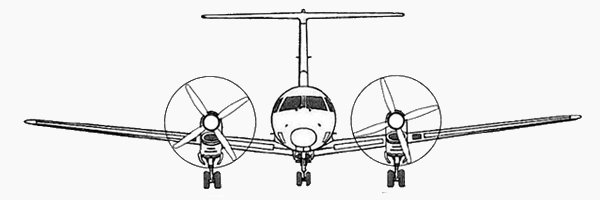
The Brasilia has a more conventional appearance and can be recognized by the low wings and long nose in front of the cockpit, which is typical of most Embraer aircraft.


The Brasilia has a more conventional appearance and can be recognized by the low wings and long nose in front of the cockpit, which is typical of most Embraer aircraft.


The Saab 340 is another low-wing turboprop similar to the Embraer Brasilia but larger. The main difference is the horizontal stabilizer is at the bottom of the tail, while the Brasilia is at the top – also called a “T” tail. Compare the illustrations to the right with the Brasilia shown above.
The Saab 340 and Embraer Brasilia are extremely similar in capacity and range. The Saab can carry 34 passengers up to 935 nautical miles while a Brasilia can carry 30 passengers up to 940 nautical miles. The Saab 340 has a higher maximum takeoff weight than the Brasilia (29,000lbs vs 25,000lbs) which would be an advantage when carrying cargo.
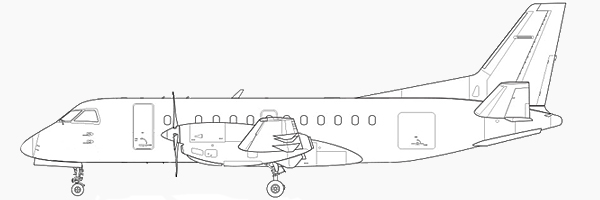
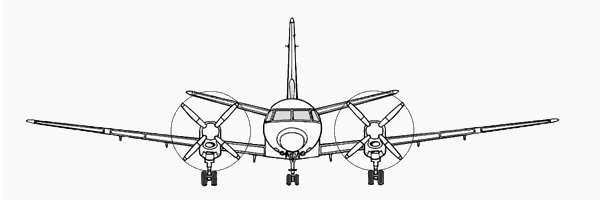
The Saab 340 is another low-wing turboprop similar to the Embraer Brasilia but larger. The main difference is the horizontal stabilizer is at the bottom of the tail, while the Brasilia is at the top – also called a “T” tail. Compare the illustrations to the right with the Brasilia shown above.
The Saab 340 and Embraer Brasilia are extremely similar in capacity and range. The Saab can carry 34 passengers up to 935 nautical miles while a Brasilia can carry 30 passengers up to 940 nautical miles. The Saab 340 has a higher maximum takeoff weight than the Brasilia (29,000lbs vs 25,000lbs) which would be an advantage when carrying cargo.


The Saab 340 is another low-wing turboprop similar to the Embraer Brasilia but larger. The main difference is the horizontal stabilizer is at the bottom of the tail, while the Brasilia is at the top – also called a “T” tail. Compare the illustrations to the right with the Brasilia shown above.
The Saab 340 and Embraer Brasilia are extremely similar in capacity and range. The Saab can carry 34 passengers up to 935 nautical miles while a Brasilia can carry 30 passengers up to 940 nautical miles. The Saab 340 has a higher maximum takeoff weight than the Brasilia (29,000lbs vs 25,000lbs) which would be an advantage when carrying cargo.



